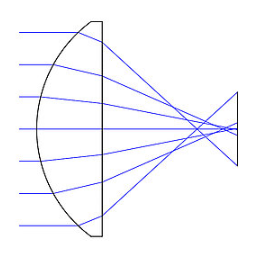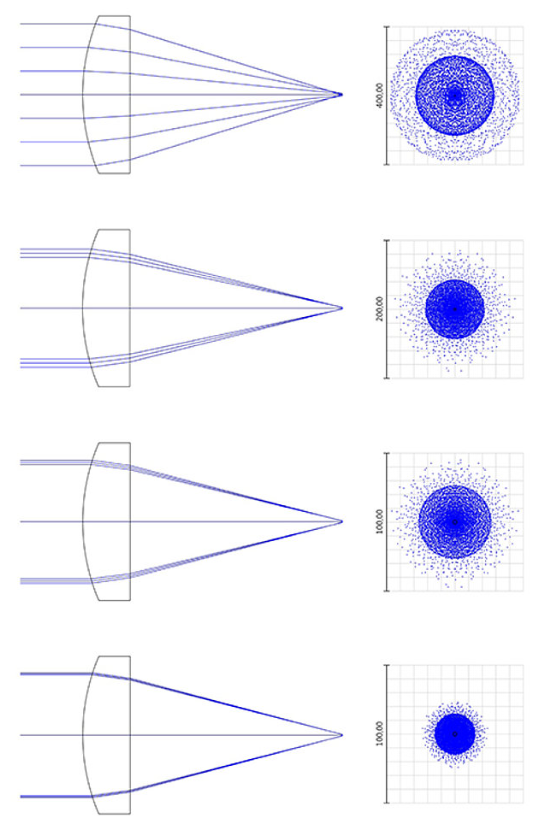Home > NEWS > Improving Focusing Quality of Spherical Lenses
The generation of Bessel beams with axicons is the most noted application for this uncommon type of aspherical surfaces. A more complex setup of combining several axicons and a common spherical lens will be the main aspect in the beam shaping consideration within this article. It will be demonstrated how the focusing performance of a spherical lens can be improved significantly by the modification of the incoming beam distribution using two axicons or as imaging errors, so-called spherical aberrations, can be corrected.
Spherical aberration is the dominant imperfection of a spherical lens. Collimated light, refracted by a spherical lens does not converge at the same focal point after passing through a spherical lens because refraction of the rays increases with their distance to the optical axis of the lens. Result of the spherical aberration is a slightly blurred image.

Imaging Properties of a spherical lens. Due to spherical aberration light rays do not meet in one focal point.
The generation of a stable collimated ring-shaped beam is compulsory for the following application. The principle setup involves monolithic beam expansion to optimize the illumination of the beam shaper and reduction to reduce the in-coming beam for the axicon. The width of the generated ring beam equals 50% of the incoming beam diameter. In order to study the focusing quality a plano-convex spherical lens is placed as the last optical element of the setup.
By reducing the incoming beam the focusing of a spheric lens can be improved since the effect of spherical aberration will be reduced. The resulting spot diagram for this spherical lens and an incoming ray bundle of 22 mm, without the axicon in the setup, the spot diameter equals 400 µm. The three following figures show spot diagrams of the same lens with different ring-shaped incoming beams with diameter 4/2/1 mm, resulting in a ring width of 2/1/0,5 mm. The last spot diagram shows a spot size of 40 µm and meets the criteria of diffraction limited focusing. This phenomenon can be explained by zonal decomposition of the spherical surface. Each zone has its own focal plane which causes spherical aberration.
By choosing just one of these zones with the ring-shaped incoming beam the spherical aberration can be avoided.

Layout of the same spherical lens with different incoming beams – (a) 22 mm (b) 4 mm (c) 2 mm and (d) 1 mm.
The variation of the position of the second axicon will influence the diameter of the ring shaped beam. Due to the zonal decomposition different ring beams illuminate different zones of the sphere which leads to a shift in the focal length. This effect can be utilized for system optimization.
Oplens company is one of the leading spherical lens manufacturers and suppliers. If you are interested in our products, please contact us now!
SPIE Photonics West Exhibition: 20 – 22 January 2026
Dec. 19, 2025Laser World of Photonics 2025 Munich
Jul. 08, 2025OHARA High Quality Quartz Fused Silica SK1300 Glass Lens
May. 21, 2025